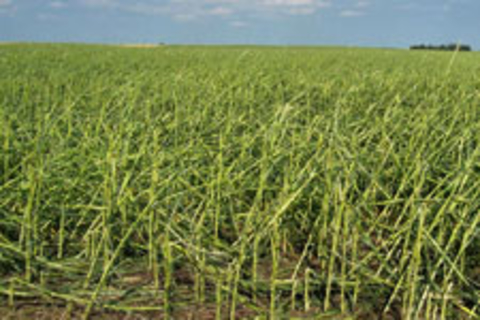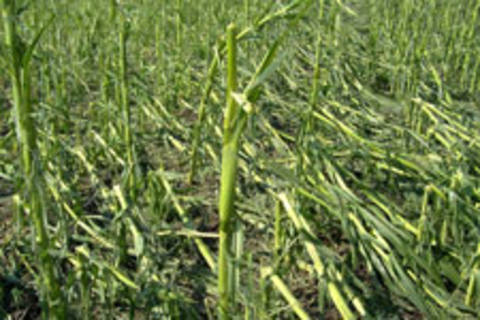Find guidance on how to manage damage from strong winds and hail when tassels are just starting to become visible or when corn has partially or completely been pollinated.
Damage can include loss of leaf area and stem bruising from hail stones, along with root lodging and stalk breakage from high winds.
Damaged caused by wind and hail
Unfortunately, corn is more susceptible to loss of leaf area from hail at tasseling and silking than at any other time in its life cycle. In general, completely losing the leaf area at this stage results in losing nearly 100 percent of yield.
Once tassels have emerged, the plant has completed its vegetative growth. This means all leaves have emerged. So, if exposed leaves are damaged, no new leaves can replace the damaged ones.
There has not been any grain fill at this point. Losing leaf area before grain fill means there will be less leaf area available to intercept the sunlight that’s needed to fill the grain. In contrast, yield reductions associated with leaf loss after grain fill has begun will be less extreme because the lost leaf area would have already contributed to grain fill.
Stem-bruised regions on the stalk are an entry point for bacterial infection and leave the plant more susceptible to future stalk breakage. If your field has considerable stem bruising, harvest it early to minimize the amount of stalks that break below the ear prior to harvest.
Foliar fungicides
It’s a common misconception that hail damage opens corn plants to infection and disease that can be controlled by fungicide applications.
Hail damage increases few corn diseases in Minnesota, with the exception of common smut, Goss’s leaf blight and wilt and, possibly, stalk rots. Foliar fungicides do not effectively manage any of these diseases.
Research results
Published research results indicate that applying fungicides to hail-damaged corn offers no significant benefit. First, in a replicated study done over two years in Illinois with simulated hail damage, foliar fungicides did not significantly reduce disease or increase yield in corn damaged by simulated hail.
In another replicated study done with simulated hail damage over three years at three locations in Iowa, foliar fungicides also did not significantly decrease disease or increase yields in plots with different levels of simulated hail damage.
Finally, crop consultants and producers have reported that when they applied fungicides to corn following hail damage in west central and south central Minnesota, there was no notable decrease in disease or increase in yield with the fungicide applications.
Although root-lodged plants are expected to "knee-up" and result in stalks with a goose-neck appearance, root lodging is expected to reduce yield.
In 1985 and 1986 in Arlington, researchers simulated root lodging on three corn hybrids by saturating the soil and pushing stalks over at the base so the stalk angle was 20 to 30 degrees from the soil surface. Averaged over the three hybrids, grain yield was reduced by 14 to 24 percent, but grain moisture at harvest was unaffected.
Stalk breakage, often referred to as green snap, is common when plants experience strong winds around tasseling. This is because plants have just completed rapid vegetative growth and the stalks are brittle.
Impact on yield
Yield reduction associated with stalk breakage depends primarily on the break’s location and the percentage of broken stalks. Plants with stalks broken above the ear can still produce grain, and unbroken plants next to broken plants can partially offset yield losses because there’s less competition for light.
However, yields reduce by an average of 0.28 percent for each percent of stalks broken above the upper ear.
For two-eared plants that broke between the upper and lower ear at tasseling, yields reduce by 0.56 percent for each percent of plants broken. This is because the plant can’t adjust the number of potential kernels on the lower ear at this stage.
Concerns about inadequate pollination arise when stalk breakage causes lost tassels. While such concerns are justified, individual tassels generally produce two to five million pollen grains.
Assuming 800 silks on each ear, this is 2,500 to 6,250 pollen grains per silk, clearly more than enough pollen to pollinate neighboring plants that have lost their tassels.
However, hail damage to ear shoots can affect silk emergence and help cause smut galls to form on ears. Silks that emerge after pollen shed has completed will not be fertilized, resulting in poor pollination and kernel set.
Poor kernel set can also occur in corn fields laid flat due to severe root-lodging just prior to pollination. This is due to ear shoots lying near the soil and being covered up by other plants, making it difficult for the silks to intercept pollen.
What to do if your field gets damaged
Growers with damaged fields should contact their crop insurance agents as soon as possible. Some producers may even consider cutting the crop for silage. Corn silage from plants with few ears will likely be wetter and have higher nitrate levels than normal.
Because the highest nitrate concentrations occur in the lower stalk, corn that is harvested for silage should be cut a few inches higher than normal, such as a 10- to 12-inch height.
Bradley, C.A. & Ames, K.A. Effect of foliar fungicides on corn with simulated hail damage. Retrieved from: https://apsjournals.apsnet.org/doi/pdfplus/10.1094/PDIS-94-1-0083.
Carter, P.R. & Hudelson, K.D. (1988). Influence of simulated wind lodging on corn growth and grain yield. Journal of Production Agriculture, 1, 295-299. http://doi.org/10.2134/jpa1988.0295.
Hicks, D.R., Naeve, S.L., & Bennett, J.M. (2018). The corn grower’s field guide for evaluating crop damage and replant options.
Hoeft, R.G., Nafziger, E.D., Johnson, R.R., & Aldrich, S.R. (2000). Modern corn and soybean production. Champaign, Ill.: MCSP Publications.
Nielsen, R.L. (2008). Recovery from hail damage to young corn. West Lafayette, Ind.: Purdue University.
Ritchie, S.W., Hanway, J.J. & Benson, G.O. (1997). How a corn plant develops. (Special Report 48). Ames, Iowa: Iowa State University.
Sisson, A., Mueller, D., & Robertson, A. (2015). Hail and fungicide use on corn.
Reviewed in 2021



